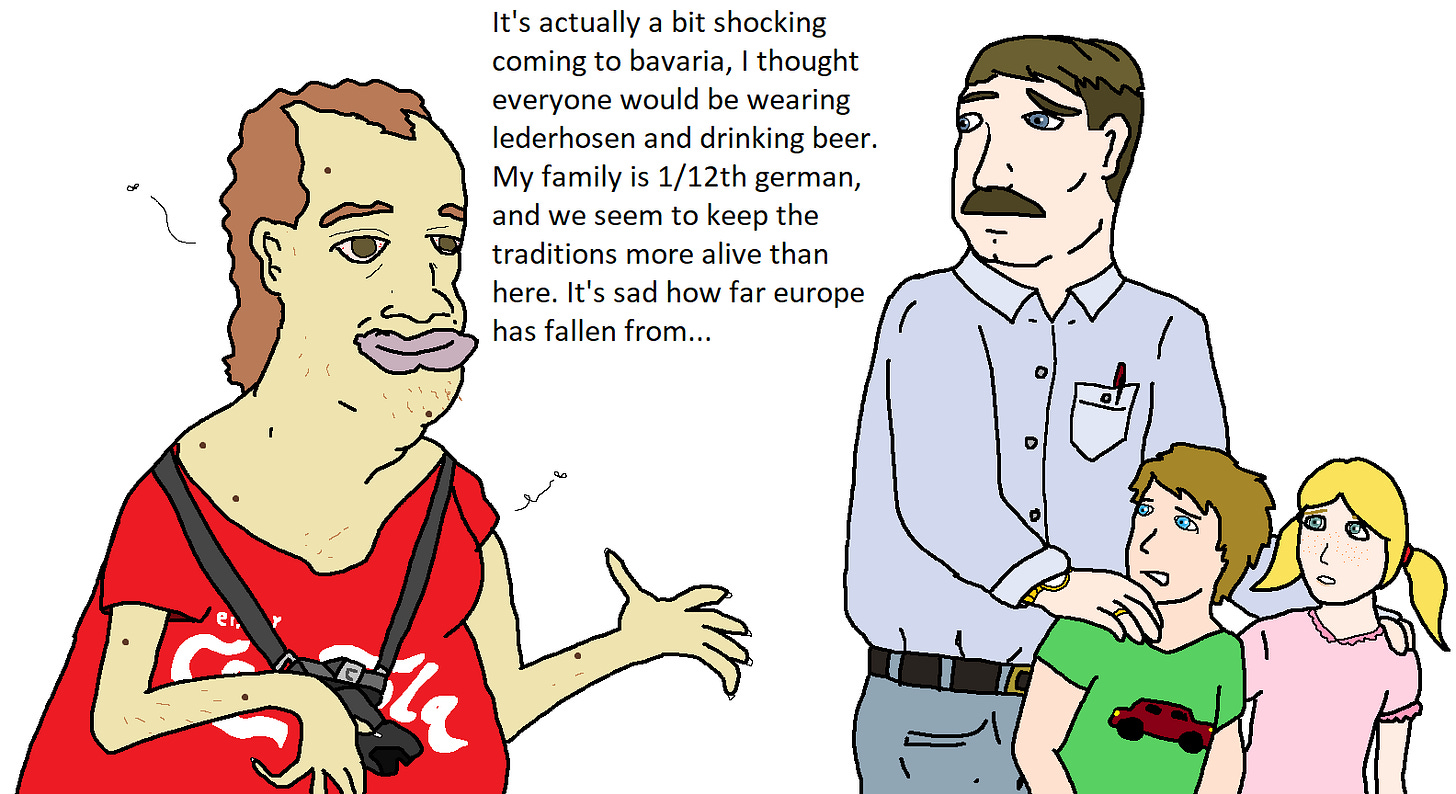In my many years as an anthropologist, I have come into contact with some of the most remote and exotic people on the planet. I have lived among the Arrernte of Central Australia, where young men undergo a ritualistic subincision ceremony that splits their penis in half. In Mauritania, I saw a girl being force-fed 20 litres of camel’s milk in a bizarre practice known as leblouh (do not research). I spent three seasons with the Ooga Booga tribe in the Boogaooga Highlands.
But perhaps the strangest specimen I have encountered in all my expeditions is the Amerimutt (also known as the Amerigoblin, Homo Americanus, El Golem Americano or El Ogro de las Americas).
Typically, I begin my ethnographic accounts with a physical description of my subjects. This involves identifying key anthropometric traits, such as cranial morphology, skeletal robusticity, height, pigmentation on the von Luschan scale, and other notable phenotypical markers.
But in the case of the Amerimutt, traditional anthropometric analysis proves nearly impossible. The subject's cranial structure and skeletal frame are hidden beneath a thick layer of subcutaneous fat. The body exists as a continuous curve without clear definition between neck, torso, and limbs. Any attempt to locate bone structure beneath the adipose accumulation is largely guesswork.
Anders Retzius (1843) observed that the Cisalpine and Mediterranean skulls are typically brachycephalic, while the Nordic exhibits distinct dolichocephalic features. The Amerimutt typically derives from an admixture between these three different populations and numerous others. We can, therefore, assume considerable phenotypic heterogeneity in cranial morphology, though direct observation remains challenging due to the aforementioned adipose abundance. Likewise, any attempt to place the Amerimutt on Felix von Luschan's chromatic scale proves futile. The Amerimutt displays such a spectrum of hues that he is essentially impossible to classify.
Having provided this admittedly insufficient and cursory physical description, I shall now turn my attention to the Amerimutt's belief system, which is unlike any I have encountered in my extensive travels.
The Amerimutt's Fluid Identity
In my travels, I have frequently encountered class and caste systems. In India, I saw the rigid social stratification between Brahmins, Kshatriyas, Vaishyas, Shudras, and the untouchable Dalits. In Rwanda, I observed similar stratification between the Tutsi and Hutu. Even in England, I witnessed elaborate deference rituals between commoners and aristocrats.
In each of these societies, one's position is determined at birth. The Indian child born to sweepers remains a sweeper. He has no illusion of choice.
By contrast, the Amerimutt is without a characteristic form or caste. He is convinced he can do just about anything and is up to playing any role. Historically, such people were called “actors”, and they were confined to the theatre. But all of America is a stage, and all the Amerimutts merely players. They have their exits and their entrances; and one man in his time plays many parts.
A boy raised by a toothless junkie in Ohio plays the role of Vice President. A bartender from the outer boroughs plays the role of Congresswoman. A mall Santa from Minnesota plays the role of Surgeon General. Men play women, and women play men. Everyone rushes frantically between costume racks. Wigs fly from head to head. A costume is secured, only to be abandoned for another.
In such an environment, it's hardly surprising that the highest office falls to a reality television impresario who has mastered the art of kayfabe. The carny is in charge of the carnival, and the clown is king of clown world.
The Amerimutt’s Historical Amnesia
Because of their mixed ancestry, the Amerimutt doesn’t identify with an ethnic group. Instead, they identify as “white.” White people like yoga, frisbee, TED Talks, Moleskine notebooks, unpaid internships, and comparing people to Hitler. They don’t like religion, racism or anything that happened prior to 1960.
Levinson and Okafor (2016) argue that miscegenation has undermined ethnos, resulting in ‘historical amnesia’ among the Amerimutt population. But even prior to substantial admixture, the American had already lost his sense of historical continuity. The migration from Europe and subsequent isolation from ancestral lands fundamentally disrupted his temporal orientation. This discontinuity was further exacerbated by the fragmentation of extended kinship networks and the rejection of European systems of social stratification.
America had "started from scratch", and so too could the American. This belief gave rise to the cultural archetype of the "self-made man," a Promethean character who sculpts himself from clay. As Tocqueville observed, "Americans believe their whole destiny is in their own hands." He also observed that the ties that formerly united one generation to another had been broken in America:
The woof of time is every instant broken and the track of generations effaced. Those who went before are soon forgotten; of those who will come after, no one has any idea: the interest of man is confined to those in close proximity to himself.
Perhaps nowhere is this severing of ancestral ties more evident than in the Ellis Island naming ritual. Names that carried centuries of cultural meaning and family history were routinely altered or abandoned altogether. Yisrael Shekelstein became Dick McRib by simply signing a piece of paper.
In America, identity is frictionless and fungible.
With no sense of connection to ancestors or descendants, the Amerimutt becomes totally preoccupied with the immediate present. He lives for himself, rather than his predecessors or posterity. This temporal shallowness breeds narcissism—a fixation on the self that finds its most refined expression in America’s therapeutic culture.
When the Amerimutt has a problem, he visits a therapist rather than a priest. The leather couch has replaced the confessional booth, and elaborate self-care routines have replaced religious rituals.
Psychological jargon provides a pseudo-scientific veneer for what amounts to ritualized self-obsession. The therapist nods approvingly as the patient discovers yet another aspect of their own psyche requiring attention, care, and endless discussion.
“I am a high-openness introvert. I experience burnout as a result of constant masking. I stim when stressed and am hyper-fixated on my interests. I'm probably autistic.”
No, you're not autistic, you're just a garden variety narcissist. Your "stimming" is fidgeting, your "hyper-fixations" are hobbies. You have no group identity, and have tried to fill that void with elaborate psychological taxonomies. Your grandfather was Irish Catholic. You're an "autistic" introvert with depression and chronic fatigue.
Detached from his predecessors and posterity, the Amerimutt has nothing left but himself. This explains the popularity of American self-help culture. Energy that previously went to family, religious groups, and civil associations is now funnelled inward. The Amerimutt finds increasingly granular ways to optimise his life. This results in frankly bizarre morning rituals—drinking structured water with trace minerals and electrolytes upon rising, performing zone 2 cardio while fasted, measuring heart rate variability with a chest strap monitor, etc.
He attributes negative emotions to biochemical imbalances rather than his severed social bonds. Depression isn't loneliness; it's a serotonin deficiency. The solution is, therefore, more supplements, more biohacking, more therapy. He adopts individualised remedies for what are, at their core, social maladies.
The Semiotics of Status in Amerimutt Culture
In my travels, I have observed numerous status signalling rituals. The men of Papua New Guinea's Highlands will stomp, yell, and flex in front of women. This form of status signalling is scarcely more sophisticated than a silverback gorilla thumping his chest.
The southwestern subspecies of Amerimutt, typically classified as El monstruo Texano, exhibits remarkably similar behaviours. He drives around in a Ford F-150 and injects exogenous hormones, such as anavar and trenbolone.
Though his methods differ from his Papua New Guinean counterpart, the signal is essentially the same: “Me big. Me loud.” Among field researchers, this behaviour is typically referred to as "Ooga Booga Signalling.”
Ooga Booga Signalling is effective in the ecological niche of America’s southwest. Research by Thornton and Weiss (2018) suggests that it’s also effective in the central plains between the two great mountain ranges. But it’s a maladaptive strategy in America's coastal settlements.
The Coastal Amerimutt doesn’t signal status through physical prowess or luxury goods. Instead, he signals status through “luxury beliefs.”
defines luxury beliefs as "ideas held by privileged people that make them look good but actually harm the marginalized." This includes things like defunding the police, prison abolition, drug decriminalisation, normalising fatherlessness, normalising obesity, normalising promiscuity,Luxury beliefs, like luxury goods, are expensive. The proles cannot afford them. A Global Synergy Alignment Strategist can afford a 2-year lockdown; a small-business owner cannot. A lawyer living in Berkeley Hills can afford to defund the police; a single mother living in South Chicago cannot. An artist (i.e., trust fund kid) in Williamsburg can afford to reject monogamy; a stay at home Mum with three kids cannot.
These luxury beliefs function as a sophisticated form of costly signalling, which anthropologists call "conspicuous destruction."
Among the indigenous peoples of the Pacific Northwest, I observed elaborate ceremonies known as potlatches. In these rituals, tribal leaders burn valuable possessions, such as food, blankets, and canoes. The message is: "I am so wealthy that I can bear costs that would devastate others."
Like the Kwakiutl chieftain, the coastal Amerimutt signals status through conspicuous destruction. But where tribal leaders destroyed their own possessions, the coastal Amerimutt destroys his own civilization. The message is: "I am so wealthy that I will remain unscathed even amid societal collapse.”
Conclusion
Despite decades of inquiry, anthropology is yet to produce a comprehensive ethnography of the Amerimutt. In this essay, I have attempted to correct this oversight by capturing the essence of the Amerimutt—only to find that no such essence exists.
Unlike traditional subjects of anthropological study, the Amerimutt cannot be defined by stable cultural practices. His identity is not inherited, but improvised. This fluidity explains why the Amerimutt has proven so resistant to traditional ethnographic classification. Just when one believes they have captured his essential nature, he transforms into something else entirely.
What remains certain is that the Amerimutt represents a novel experiment in human organization—one that has uprooted the individual from tribe, tradition, and territory. The long-term consequences of this experiment remain to be seen, but the preliminary findings documented here suggest grounds for both fascination and concern.










Honestly this was one of the most enjoyable essays I’ve read on this site. It’s such a shame that the GAE has spread so much of the American mentality to Europe.
so fucking good man!